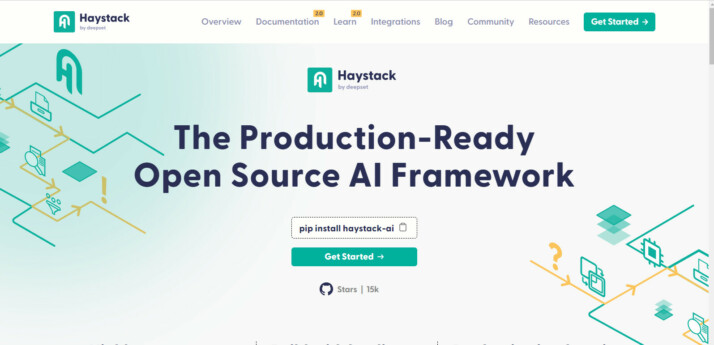Haystack vs. Magic Loops: Comparing AI Development Platforms
AI-powered automation and development platforms are revolutionizing how businesses create intelligent applications. Haystack vs. Magic Loops, and SmythOS each offer unique approaches to harnessing AI capabilities, catering to different technical expertise levels and use cases. This comparison examines the strengths and limitations of these platforms, exploring their core features, development environments, and deployment options. By analyzing how each tool handles tasks like retrieval-augmented generation, natural language processing, and workflow automation, we’ll uncover which platform best suits various business needs—from enterprise-scale AI applications to accessible automation for non-technical users. Our review aims to equip developers, business leaders, and AI enthusiasts with the insights needed to choose the ideal platform for building powerful, scalable AI solutions.
Haystack Overview
Haystack empowers developers to build advanced AI applications using Large Language Models (LLMs) and vector search. This open-source framework excels at tasks like retrieval-augmented generation, question answering, and conversational AI. Haystack’s modular architecture allows developers to create custom pipelines by combining components for tasks such as document processing, retrieval, and generation.
Haystack integrates seamlessly with popular AI tools and models, including Hugging Face Transformers, Elasticsearch, and offerings from OpenAI and Anthropic. This flexibility enables developers to leverage cutting-edge AI capabilities while maintaining control over their applications. Haystack’s strength lies in its ability to handle complex queries by orchestrating LLMs and efficient retrieval methods.


Haystack empowers developers to build advanced AI applications using Large Language Models (LLMs) and vector search. This open-source framework excels at tasks like retrieval-augmented generation, question answering, and conversational AI.
The framework supports a wide range of use cases, from building intelligent search systems to powering conversational interfaces. Haystack’s document stores and retrieval mechanisms ensure contextual relevance, while its support for AI agents allows for autonomous decision-making and problem-solving. The system can process and index various document formats, including PDFs and Word files, making it versatile for content-heavy applications.
While Haystack offers powerful capabilities, it requires coding knowledge to fully utilize. The lack of a visual builder or no-code editor may present a learning curve for non-technical users. However, for developers and data scientists, Haystack provides a robust platform for creating sophisticated AI-driven applications.
Haystack’s parent company, deepset, offers a cloud-based solution that complements the open-source framework. This managed service streamlines the lifecycle of NLP application development, from prototyping to production deployment. The combination of Haystack’s flexibility and deepset Cloud’s enterprise features positions the platform as a compelling option for organizations seeking to harness the power of AI in their applications.
Magic Loops Overview
Magic Loops transforms automation by seamlessly blending large language models with code to create programmable workflows. Users describe tasks in natural language, which the platform converts into executable “loops” combining code and AI blocks.


The platform’s key strengths lie in its accessibility and flexibility. Users can easily modify loops to match specific requirements, ensuring precise automation. Magic Loops leverages various integrations, APIs, and language models, making it a versatile tool for complex task automation.
Magic Loops transforms automation by seamlessly blending large language models with code to create programmable workflows. Users describe tasks in natural language, which the platform converts into executable “loops”…
Magic Loops fosters collaboration through its public loops feature, allowing users to share and utilize community-created workflows. This open approach extends to the company’s plans to open-source the platform, enabling local deployment and customization.
The platform has successfully shipped with several pre-built loops and templates, including a YC S23 Watcher that texts users about the latest Y Combinator launches, and a Bland AI Demo that triggers AI phone calls upon email receipt. These examples showcase the platform’s diverse application potential.
Magic Loops aims to democratize programming by bridging the gap between no-code/low-code tools and full-code environments. Their vision involves making programming accessible to a wider audience, potentially increasing the number of people who can code from 1 in 200 to 1 in 5. By leveraging state-of-the-art generative AI, Magic Loops empowers users with programming capabilities without requiring extensive coding knowledge.
Feature Comparison
Haystack and Magic Loops offer distinct approaches to AI agent development, with notable differences in their core components and security features. Haystack provides a robust framework for building advanced AI applications using Large Language Models (LLMs) and vector search, excelling in tasks like retrieval-augmented generation and question answering. Its modular architecture allows developers to create custom pipelines by combining various components. However, Haystack lacks a visual builder or no-code editor, which may present a learning curve for non-technical users.
Magic Loops, on the other hand, focuses on transforming natural language descriptions into executable “loops” that combine code and AI blocks. This approach makes automation more accessible to users without extensive coding knowledge. Magic Loops offers flexibility in modifying loops to match specific requirements and leverages various integrations and APIs. However, it does not provide the same level of advanced AI capabilities and customization options as Haystack.
In terms of security, Haystack integrates with enterprise-level solutions through deepset Cloud, likely offering robust data encryption and authentication methods. Magic Loops’ security features are less explicitly detailed, which may be a concern for users handling sensitive data or requiring stringent security measures. Both platforms support scalability and deployment options, but Haystack’s integration with various foundation models and extensive API support gives it an edge in terms of versatility for complex AI applications.
Feature Comparison Table
| Haystack | Magic Loops | SmythOS | |
|---|---|---|---|
| CORE FEATURES | |||
| Hosted Agents (Dev, Production) | ✅ | ❌ | ✅ |
| Environments (Dev, Production) | ✅ | ❌ | ✅ |
| Visual Builder | ❌ | ❌ | ✅ |
| No-Code Options | ❌ | ✅ | ✅ |
| Autonomous Agents | ✅ | ❌ | ✅ |
| Multimodal | ✅ | ❌ | ✅ |
| Multi-Agent Collaboration | ✅ | ❌ | ✅ |
| Audit Logs for Analytics | ✅ | ❌ | ✅ |
| Work as Team | ✅ | ❌ | ✅ |
| Agent Work Scheduler | ❌ | ✅ | ✅ |
| SECURITY | |||
| Constrained Alignment | ❌ | ❌ | ✅ |
| Data Encryption | ✅ | ❌ | ✅ |
| OAuth | ✅ | ❌ | ✅ |
| IP Control | ❌ | ❌ | ✅ |
| COMPONENTS | |||
| Foundation AIs | ✅ | ❌ | ✅ |
| Huggingface AIs | ✅ | ❌ | ✅ |
| Zapier APIs | ❌ | ❌ | ✅ |
| Classifiers | ✅ | ❌ | ✅ |
| Data Lakes | ❌ | ❌ | ✅ |
| DEPLOYMENT OPTIONS (EMBODIMENTS) | |||
| Staging Domains | ❌ | ❌ | ✅ |
| Production Domains | ❌ | ❌ | ✅ |
| Deploy as Site Chat | ✅ | ❌ | ✅ |
| Deploy as Scheduled Agent | ❌ | ✅ | ✅ |
| Deploy as GPT | ✅ | ❌ | ✅ |
| DATA LAKE SUPPORT | |||
| Sitemap Crawler | ❌ | ❌ | ✅ |
| YouTube Transcript Crawler | ❌ | ❌ | ✅ |
| URL Crawler | ✅ | ❌ | ✅ |
| PDF Support | ✅ | ❌ | ✅ |
| Word File Support | ✅ | ❌ | ✅ |
| TXT File Support | ✅ | ❌ | ✅ |
Best Alternative to Haystack and Magic Loops
SmythOS emerges as the superior alternative to Haystack and Magic Loops, offering a comprehensive agentic AI automation platform that combines ease of use, extensive features, and unlimited use cases. Our drag-and-drop interface allows users to create sophisticated AI workflows without extensive coding knowledge, democratizing AI development across various industries.
SmythOS emerges as the superior alternative to Haystack and Magic Loops, offering a comprehensive agentic AI automation platform that combines ease of use, extensive features, and unlimited use cases.
Unlike Haystack’s complex framework and Magic Loops’ limited automation capabilities, SmythOS provides a complete ecosystem for AI agent development and deployment. We support a wide range of AI models, including those from OpenAI, Anthropic, and Hugging Face, empowering users to leverage cutting-edge AI technologies effortlessly.
SmythOS stands out with its robust security features, including data encryption, OAuth integration, and IP control, addressing the limitations found in both Haystack and Magic Loops. Our platform offers unparalleled scalability, supporting enterprise-level deployments while maintaining performance and efficiency.
Our extensive integration ecosystem sets SmythOS apart, allowing seamless connections with various APIs, data sources, and tools. This flexibility ensures that SmythOS can adapt to virtually any workflow or business process, surpassing the capabilities of both Haystack and Magic Loops. Additionally, our pre-built API integrations and templates significantly reduce setup time, enabling users to focus on innovation rather than configuration.
With SmythOS, users gain access to advanced features like multi-agent orchestration, autonomous agent capabilities, and versatile deployment options.
With SmythOS, users gain access to advanced features like multi-agent orchestration, autonomous agent capabilities, and versatile deployment options. These functionalities enable the creation of sophisticated AI solutions that can be integrated into existing systems seamlessly, outperforming both Haystack and Magic Loops in terms of versatility and adaptability. By choosing SmythOS, users unlock the full potential of AI, driving significant advancements across industries and revolutionizing their workflows.
Conclusion
Haystack, Magic Loops, and SmythOS each offer unique approaches to AI-powered automation and development, catering to different user needs and technical expertise levels. Haystack excels in building advanced AI applications with its open-source framework, particularly for tasks like retrieval-augmented generation and question answering. Magic Loops transforms natural language descriptions into executable workflows, making automation more accessible to non-technical users.
While both platforms have their strengths, SmythOS emerges as the superior choice for businesses and developers seeking a comprehensive, user-friendly AI development environment. SmythOS combines the power of advanced AI capabilities with an intuitive drag-and-drop interface, enabling users to create sophisticated AI agents without extensive coding knowledge. Its extensive integration ecosystem, supporting over 300,000 connections, surpasses the offerings of both Haystack and Magic Loops, allowing for seamless incorporation into existing workflows.
SmythOS’s “Create Once, Deploy Anywhere” approach sets it apart, offering unparalleled flexibility in deploying AI agents across various platforms and services. This versatility, coupled with robust features like multi-agent collaboration, advanced security measures, and scalable infrastructure, makes SmythOS the ideal choice for businesses looking to leverage AI at scale.
For those ready to experience the future of AI development and automation, we invite you to explore SmythOS’s diverse range of AI-powered agent templates. These templates cover multiple business categories and offer a quick start to revolutionizing your workflow. To get hands-on experience with SmythOS’s capabilities, create a free SmythOS account and start building AI agents with no time limit or risk. Unlock the full potential of AI for your business and join the forefront of the AI revolution with SmythOS.
Last updated:
Disclaimer: The information presented in this article is for general informational purposes only and is provided as is. While we strive to keep the content up-to-date and accurate, we make no representations or warranties of any kind, express or implied, about the completeness, accuracy, reliability, suitability, or availability of the information contained in this article.
Any reliance you place on such information is strictly at your own risk. We reserve the right to make additions, deletions, or modifications to the contents of this article at any time without prior notice.
In no event will we be liable for any loss or damage including without limitation, indirect or consequential loss or damage, or any loss or damage whatsoever arising from loss of data, profits, or any other loss not specified herein arising out of, or in connection with, the use of this article.
Despite our best efforts, this article may contain oversights, errors, or omissions. If you notice any inaccuracies or have concerns about the content, please report them through our content feedback form. Your input helps us maintain the quality and reliability of our information.
